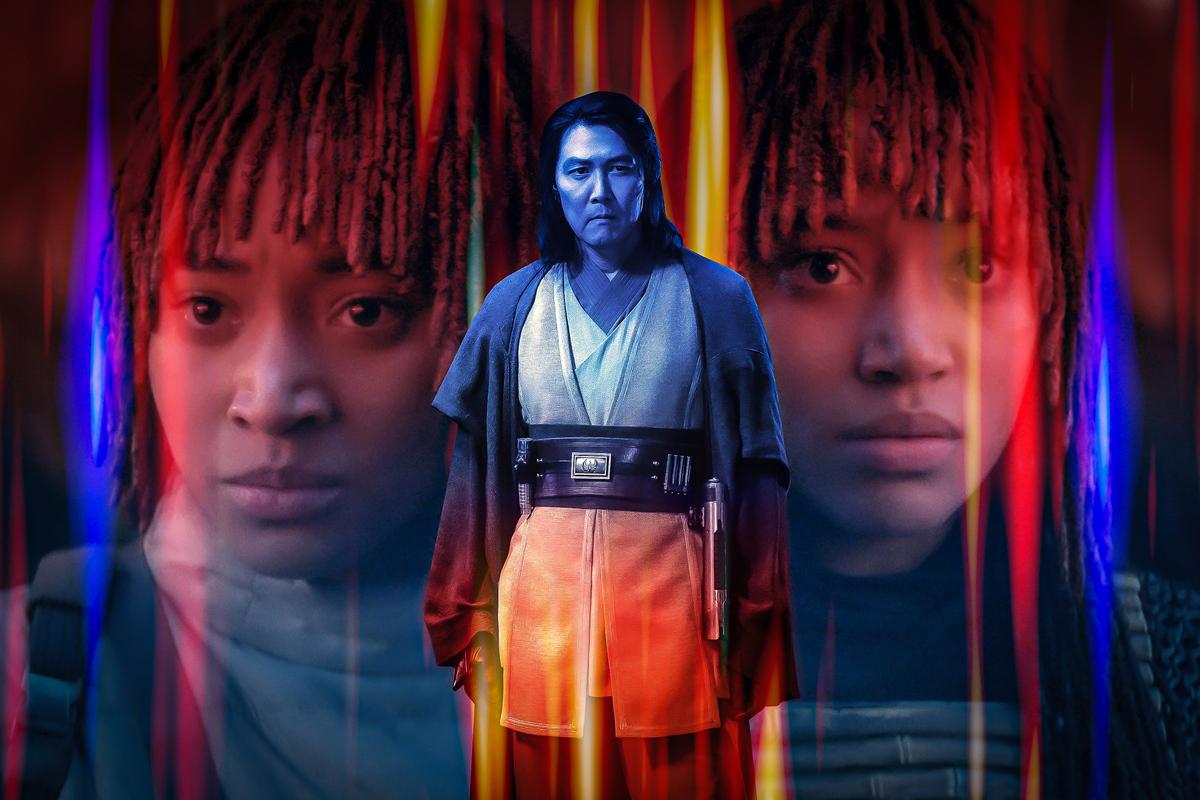

When Disney wants to sell the ending of a latter-day Star Wars movie or series—to provoke cries of recognition, go out on a high note, and send viewers home happy—it often tries a good trick: showing a legacy character. These characters don’t necessarily have to do anything. They don’t necessarily have to say anything. They just have to be present as the credits roll, reminding you of your youth and eliciting Star Wars nostalgia.
Rogue One could have ended with original characters Cassian Andor and Jyn Erso embracing on Scarif, taking solace in their closeness and the knowledge that they’d died doing their job. Instead, the camera cut from that movie’s main characters to close with a Darth Vader rampage and an awkwardly de-aged Carrie Fisher. Solo ended with Qi’ra talking to a holographic Darth Maul. The Force Awakens ended with a silent Luke Skywalker staring at Rey. And The Rise of Skywalker ended with Rey looking at Luke and Leia.
It happens on the small screen, too. The Mandalorian’s second season ended with a (slightly less awkwardly) de-aged Mark Hamill entering a turbolift with R2-D2 and Grogu. (Speaking of Grogu, the ending of The Mandalorian’s premiere almost followed this formula too—not with Yoda, but Baby Yoda.) Obi-Wan Kenobi ended with an about-to-be-old Ben communing with Qui-Gon. Heck, even Andor Season 1 ended with a close-up of the Death Star. I suppose we could count Anakin Skywalker’s Force ghost smiling at the end of Ahsoka Season 1—but then, that’s also how the original trilogy ends.
So I suppose it would have been an upset if The Acolyte’s first season hadn’t ended with a glimpse of the one well-loved legacy character kicking around at this point in the timeline. Sure enough, there he is in the final few seconds, seen from behind his familiar long ears and green, wrinkled head—tufted, perhaps, with a tad more white hair than we’re used to seeing. (The diminutive master is not 900 years old yet, but pushing 750.) You seek Yoda, the series seems to be saying. Well, here he is!
Some Disney Star Wars releases are explicitly centered on legacy characters, and others are clearly pitched as prequels or sequels that set up or extend existing stories. One can’t complain when an exercise in nostalgia does what it says on the tin. I’ll never get sick of old Star Wars, and emotionally, I’m not more machine now than man: Some of those callbacks and cameos get me going. Vader laying waste to terrified Rebels in a narrow hallway? Luke dicing up Dark Troopers and ruining Moff Gideon’s day? Don’t mind if they do. But the thrill wears off when you realize that almost every live-action Star Wars release culminates in the same finishing move, one that positions the series’ past as the star.
Or … maybe the thrill doesn’t wear off, for the fans the franchise is trying to target. No matter how many times Disney drops the same mic, it still seems to land, at least in terms of generating instant interest. “Star Wars is thriving,” read one viral tweet about the Acolyte finale, accompanied by pictures of two characters, Yoda and Darth Plagueis, who combined for a few seconds of unspeaking screen time. “If seeing Master Yoda isn’t enough reason why The Acolyte should get a second season I don’t know what the hell is,” said another.
Well, establishing its own compelling characters and narrative is what would most make me want to watch: If I want to see Yoda, there are plenty of other places to find the green guy in the Disney+ app. That The Acolyte, a series set a century before the prequels, seems prepared to pivot harder into laying the groundwork for (and foreshadowing) those films bums me out a bit. We have a whole raft of releases dedicated to explaining how Palpatine returned. Do we need another set explaining how he rose? Hemmed in as they’d be by the same incontrovertible canon constraints that limit later stories?
Perhaps that’s a fear for the future, should The Acolyte continue. (Always in motion are Lucasfilm’s plans.) For now, let’s focus on the finale. Ironically, the last episode’s success didn’t depend purely on the DiCaprio-pointing potential of that last-second stinger. Episode 8, “The Acolyte,” directed by Hanelle M. Culpepper and written by Jason Micallef, made a decent case for a second season without the promise of more Master Yoda. In fact, until that final shot, the finale pulled off the impossible: It almost made me forget that in Star Wars, every on-screen project is a prelude or a postscript to something else.
Although it can’t quite polish up some of the series’ strange decisions, the latest (and possibly last) installment is probably the second best of the season, after the Episode 5 free-for-all. This time, the body count isn’t quite so high—congrats to this week’s Jedi redshirts for surviving the season—but the one notable death is a (predictable) doozy.
The Acolyte’s eponymous finale is the longest episode of the season, and unlike some earlier installments, it uses most of its time well. As one would expect from a finale, the episode is stuffed with more of the series’ signature fights, which have, if anything, grown more ingenious and distinctive (by Star Wars standards) as the season has proceeded. In one confrontation, Sol and the Stranger showcase Crouching Tiger, Hidden Dragon–esque gravity defiance; in another, Osha and Mae fight each other to a mirror-image standstill, each able to anticipate the other’s every move. The showdown between Sol and the Stranger, which includes some sick Force deflections, ends with the classic samurai story trope of a single-stroke battle, which results in the severing of the Stranger’s saber. There’s even the occasional visual flourish from the filmmakers, as with this mid-duel match cut.
“The Acolyte” boasts some Andor-esque celestial spectacle in the chase through the ice rings of Brendok’s moons. It layers in a lot of lore, most notably in the brief glimpse we get of Palpatine’s future master, Darth Plagueis, and the first on-screen depiction of a kyber crystal being “bled” to turn a saber red, which makes Osha’s saber briefly look like a Firecracker Popsicle. (Someone set that scene to “Love Lies Bleeding.”) And yes, it makes time for a couple of quotes or paraphrases from the original trilogy. Master Vernestra describes the Stranger as “a pupil of mine before he turned to evil,” echoing Obi-Wan’s words in Episode IV. And the Stranger urges Mae, “Strike him down, and your journey will be complete,” anticipating Palpatine’s instructions to Luke in Episode VI. (If both the Stranger and Palpy were pupils of Plagueis, I suppose it makes sense for them to use similar language.)
Ultimately, the climax comes down, as it must, to Osha’s relationships with her sister and with her former and future teachers: Sol and the Stranger, respectively. It ends in an unsurprising place: with Osha killing Sol—without a weapon, no less—and taking Mae’s place by the Stranger’s side. In Osha’s vision inside the Stranger’s cortosis helmet at the start of the episode, she sees Mae facing Sol and holding a saber outstretched, which Osha interprets as a threat to her former master’s life. In time-honored self-fulfilling prophecy fashion, Osha’s rush to find Sol to save him from Mae leads to Osha killing him instead, having heard Sol confess to killing Mother Aniseya. As Sol protests his innocence, Osha tells him twice to “stop talking.” Then she makes him stop by Force choking the life out of him, rejecting her Padawan past and Jedi dreams in the process. The outcome was foreseeable, but it’s brutal nonetheless.
The greatest flaw in the finale was also something of a constant shortcoming this season: the shaky characterization of Osha and Mae. Osha’s about-face from Sol superfan to his murderer was as abrupt as Mae’s Episode 4 flip from true believer to betrayer. Yet even after slaying her former master, Osha’s initial impulse is to explain herself to the order. Meanwhile, Mae immediately consents to having huge portions of her memory erased so that she can turn herself over to the Jedi without compromising the Stranger. The takeaways from these supposed-to-be-cathartic scenes are murky. Osha chooses to train with the Stranger to … save Mae from her former Master? (Maybe that’s just a justification for her own dark side streak.) And Sol … wasn’t so bad after all? “Sol never blamed you,” Osha tells Mae. “He tried to teach me that someone I loved could be capable of this level of destruction.” What? He definitely did blame Mae! And if you think he was just trying to teach a valuable lesson, why did you murder him?
All in all, these girls can’t seem to make up their minds—or the show can’t make up its mind about them. Maybe it makes sense that the twins would be mercurial, given their traumatic pasts and unique nature, but I’ve had a tough time tracking their arcs—or, by extension, deeply caring about their characters. “What do you want, Osha?” Mae asks. I’m not sure I have a handle on what either of them wants, but then, they may not either. Manny Jacinto and Lee Jung-jae may have stolen most of the scenes they were in regardless of how Osha and Mae were written, but the development of the series’ nominal main character(s) didn’t do Amandla Stenberg any favors.
Sol’s unrepentant stance in this episode is also kind of confounding. Why does he go to his grave so convinced that the twins were in danger before he and Torbin meddled on Brendok? Did Sol know something about the witches we don’t? Even as he protests too much, though, Sol resigns himself to his fate, as Torbin did, rather than resist the fatal Force choke. “Osha, it’s OK,” he says, offering his former apprentice the forgiveness she won’t give him. Rest in Force power, Master Sol; I’m sorry the Senate thinks you’re a monster. You were easy to root for, until last week.
The finale also relies on Vernestra as a load-bearing character, a role that the rest of the season didn’t prepare her (or the audience) for. I haven’t vibed with Rebecca Henderson’s performance as the Mirialan master, but beyond that, I just don’t know enough about Vern to get in her head as she tries to sweep the Stranger under the rug by blaming Sol for all the Jedi deaths. For the season to end with Vernestra addressing Yoda seems like a misread of the show’s strengths.
“It feels like everyone’s really expecting [their shows] to get a second season, and I don’t feel that’s a good idea,” creator Leslye Headland told Entertainment Weekly last month. “I threw everything into season 1, because who knows what’s going to happen?” Before the finale, she told Nerdist, “We definitely aren’t going to leave you hanging.” The episode offered enough resolution that it didn’t solely (Sol-ly?) seem like setup for a second season, but “The Acolyte” would be far from a fulfilling conclusion if the series stops here.
In confirming some theories, “The Acolyte” creates room for new ones. The episode establishes that the Stranger was once Vernestra’s Padawan, though it doesn’t go deeper than that. (Which is fine: It was better for the finale to focus on backstory we’ve seen.) It reveals how Osha survived her fall on Brendok (as it turns out, much like Luke survived his fall in Cloud City). Most important, it offers proof of Plagueis. “Is that Darth Plagueis’s music?!” I asked last week. It was—and his music sounds a lot like the opera Palpatine and Anakin are watching in Revenge of the Sith when Palpy name-drops his old master.
Of course, we still know next to nothing about Plagueis’s part in these events. Was he the Stranger’s master, and if so, is he still? Why is he creeping in a cave, like the Crabfeeder? (As badass Sith introductions go, this one wasn’t exactly on par with the Stranger’s horror movie entrance in Episode 5.) Did he help create Mae and Osha as a trial run—“The girls are guinea pigs. They’re patient zero for this sort of power,” Headland has said—or learn the technique from the witches? (And, speaking of the witches, where is Mother Koril?) How did Brendok’s vergence appear? In the old Legends timeline, Plagueis becomes convinced that midi-chlorians created Anakin to doom the Sith in response to Plagueis’s prior attempts to create the Chosen One. Is The Acolyte recreating that history? Or will it turn out that Anakin was created on purpose by Plagueis and/or Palpy? Also, I say this as a Star Wars obsessive, but: Do we really need to know? Must every new on-screen Star Wars story be about old Star Wars series’ loose ends?
Yoda and Plagueis make fitting opponents—whether the former learns of the latter or not—in that one has a naturally long lifespan and the other resorts to unnatural means of avoiding death. And in theory, Mae’s mind wipe provides the possibility that some member of the Jedi could discover the Sith threat and then be Forced to forget it. This episode also doubles down on another element that might play a more prominent part in a second season: the Senate’s increasing suspicion of the Jedi, which will eventually help create the conditions for Palpy to pull off Order 66.
“You project an image of goodness and restraint, but it’s only a matter of time before one of you snaps,” impressively prescient Senator Rayencourt (David Harewood) tells Vernestra. “And when, not if, that happens, who will be strong enough to stop him?” If only one of the Jedi could have foreseen Anakin’s descent as clearly as this senator somehow did almost a century before Anakin’s birth. Rayencourt, Aniseya, and Bazil (whose reason for sabotaging Sol’s ship could have been better illuminated) seem more perceptive on their own than the entire order put together. (I know I’m supposed to love Bazil, by the way, but his sniffing and scurrying always seemed out of place in this largely humorless series.)
Are those ingredients enough for a renewal? I can’t say I’d be heartbroken if Disney opts not to make more Acolyte—a plausible scenario, considering the series’ lofty price tag and underwhelming viewership stats, by Star Wars standards. (“I don’t know when that decision will be made,” Headland told Nerdist.) Given this season’s stumbles, the opportunity cost is considerable, not just financially but creatively, too. Talking to Nerdist about Osha and Mae, Headland said, “It’s like when you’re doing an experiment and it’s the first round of it. … The twins are weaker than Anakin, for sure. They are going to fall short of what will eventually become the Chosen One. They will never achieve what that is.” If The Acolyte limits itself to telling the first draft of the franchise’s preexisting story—as opposed to, say, a stand-alone saga like the High Republic books and comics, which use Yoda as no more than a supporting piece—then it will fall short of achieving its potential, too.
Maybe that vision, unlike the one of Sol’s demise, can still be avoided. The episode ends—well, almost ends—with a shot of Osha and the Stranger clasping hands, looking like Cassian and Jyn, or even like Luke gazing at Tatooine’s twin suns. I would have preferred for the season to end on that image. It’s the one that will stay with me. The one that makes me want to watch more. The one that makes me hope for a strong second act, unburdened by the flashbacks and the Rashomon homage that hamstrung this season’s structure. (Unless Headland has further, full-length flashbacks to the Stranger’s Jedi training in store.)
What excites me most about the prospect of a second season—well, aside from the chance to see what the series’ fight choreographers can do with a lightwhip—is the potential to explore Osha’s individual journey down the dark path, not from the Jedi’s familiar point of view, but from hers and that of the semi-sympathetic, sexy Sith whose hand she’s holding. “Is the dark side stronger?” Luke asks Yoda in The Empire Strikes Back. His mentor dismisses the idea, but it remains an open question. The Acolyte may be our best bet for an honest answer, if it gets the chance to supply one.


